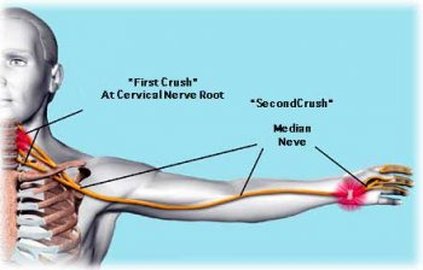Double Crush Syndrome
This is a type of peripheral nerve compression that is combined with a central compression that impacts the nerve bundle, such as in the thoracic triangle. If there are two points of nerve compression it will be difficult to diagnose only entrapment or the encompassing TOS. The physical therapist must be cognizant of any associated neural tissue irritations or entrapments along the entire course of the peripheral nerve route. The therapist will consider the possibility of a double crush, meaning both a nerve entrapment and thoracic outlet syndrome. Furthermore, a patient with a positive peripheral nerve entrapment is at risk for developing a symptom profile very similar to TOS. Therefore, the practitioner is encouraged to perform testing that is relevant to TOS along with screen for peripheral nerve problems. When there is significant evidence of an isolated peripheral nerve entrapment/irritation and the practitioner can rule out TOS, (by detecting negative findings on TOS provocation tests and the thoracic outlet container test) then there is little suspicion of a double crush. The potential of a double crush syndrome causes the clinical presentation and differential diagnosis of thoracic outlet syndrome to be more challenging.
(Hooper et. al., 2010)
(Hooper et. al., 2010)

